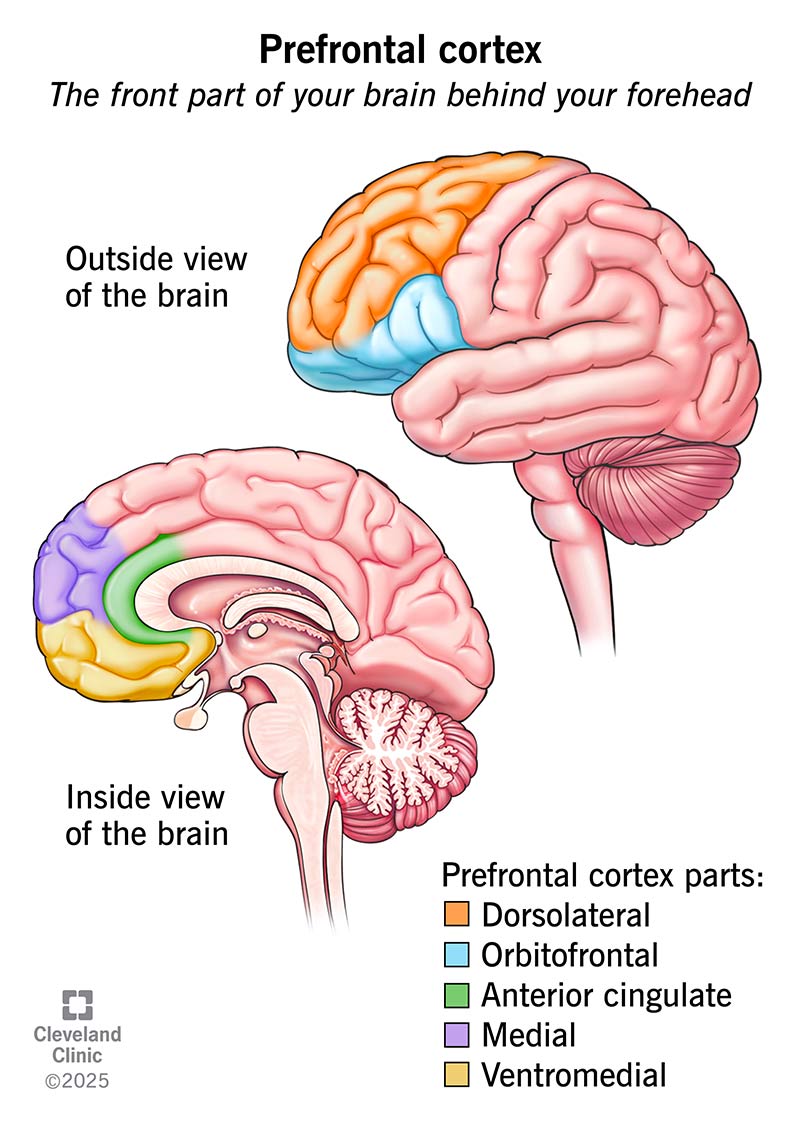The prefrontal cortex helps with attention, emotions, self-control and decision-making. This part of your brain sits behind your forehead. It takes time to fully mature and doesn’t finish developing until your mid-20s. Damage or conditions like ADHD or depression can affect it. You can strengthen it with mindfulness, learning and staying active.
Advertisement
Cleveland Clinic is a non-profit academic medical center. Advertising on our site helps support our mission. We do not endorse non-Cleveland Clinic products or services. Policy

The prefrontal cortex is the front part of your brain, right behind your forehead. It helps manage thinking, emotions and behavior by using executive functions. These are skills you rely on to plan, make decisions, solve problems, stay focused and adjust to new situations.
Advertisement
Cleveland Clinic is a non-profit academic medical center. Advertising on our site helps support our mission. We do not endorse non-Cleveland Clinic products or services. Policy
The prefrontal cortex (PFC) is the last part of your brain to finish myelination. This usually happens in your mid-20s. Myelination is when a protective covering (sheath) forms around the brain’s wiring (nerve fibers, also called neuronal axons). This covering helps signals travel faster, so information moves quickly from one part of the brain to another.
The PFC is an important part of what makes you who you are, and it has a big impact on your daily life.
Several conditions can affect this part of your brain, including epilepsy, ADHD, OCD and depression, among others. Damage to it can change the way you interact with the world. A healthcare provider can help diagnose and treat problems with your prefrontal cortex to help you feel better.
The PFC guides many of your everyday skills. Some of its main jobs include:
Advertisement
Your prefrontal cortex is above and behind your eyebrows and forehead. It’s in the front part of your brain’s frontal lobe.
The prefrontal cortex has different sections. Each one has its own job:
Your prefrontal cortex is one of the last parts of your brain to fully mature. Its basic structure forms in childhood. But it keeps changing throughout your teen years and into early adulthood.
During this time, your brain strengthens the connections it uses most. Then, it lets go of the ones it doesn’t need. It also adds insulation (called myelin) to help signals travel faster and more smoothly.
These changes improve judgment, self-control and long-term planning. For most people, the PFC fully develops by the mid-20s. Fine-tuning may take a bit longer.
The prefrontal cortex plays a role in many health conditions, like:
Damage to the PFC can have a big impact on how you think, feel and act. It can change your personality, affect your judgment and make it harder to control emotions or behavior.
If you have this type of brain injury, you may struggle with planning, decision-making or adapting when things change. You might also have trouble focusing, remembering things or managing your impulses.
Even though skills like speech and intelligence can stay the same, damage to this area often makes everyday tasks more challenging.
When this part of your brain isn’t working as it should, you might notice:
Advertisement
Tell a healthcare provider if these affect your daily life. They can help find the cause and suggest treatment options that fit your needs.
Even after your prefrontal cortex fully develops, it can still change and adapt. This is called neuroplasticity.
Neuroplasticity means your brain can build new pathways and strengthen old ones when you learn, practice or repeat certain activities.
Since the PFC is your brain’s center for decision-making, focus and self-control, it benefits from this process. The more you challenge it, the stronger these skills can become.
You can support neuroplasticity and keep your PFC strong by:
Have you ever tapped your finger on your forehead while trying to make a tough decision or figure out a plan? You were actually pointing to the area of your brain that helps with those things.
It’s easy to overlook how important your prefrontal cortex is. It helps you focus when you’re finishing work, manage your emotions when you’re stuck in traffic and set goals like saving money for something you want. It also plays a big part in how you interact with others, like calming down during an argument or deciding the right words to say to a friend.
Advertisement
If you notice changes in your focus, mood or behavior, don’t ignore them. Tell a healthcare provider — they’re here to help.
Advertisement
If you have a neurological condition, you want expert advice. At Cleveland Clinic, we’ll work to create a treatment plan that’s right for you.

Last reviewed on 09/26/2025.
Learn more about the Health Library and our editorial process.